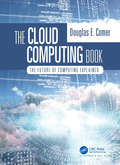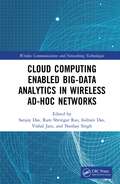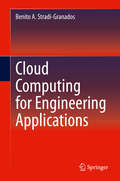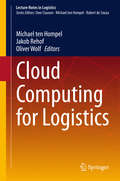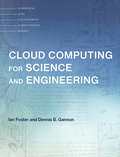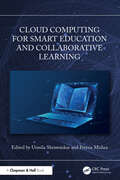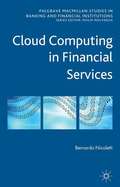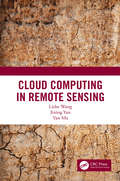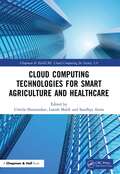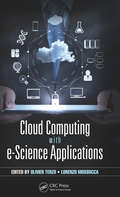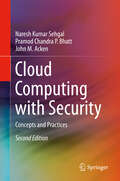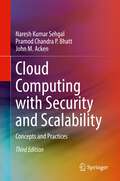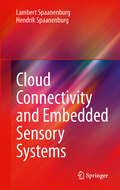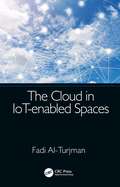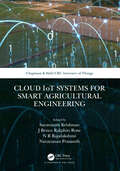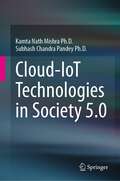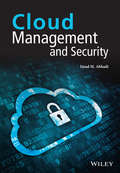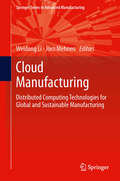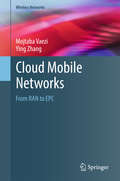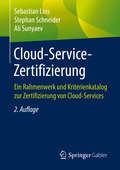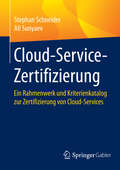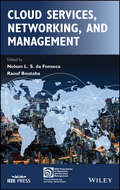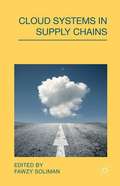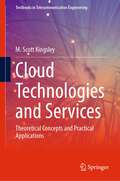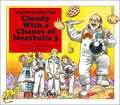- Table View
- List View
The Cloud Computing Book: The Future of Computing Explained
by Douglas ComerThis latest textbook from bestselling author, Douglas E. Comer, is a class-tested book providing a comprehensive introduction to cloud computing. Focusing on concepts and principles, rather than commercial offerings by cloud providers and vendors, The Cloud Computing Book: The Future of Computing Explained gives readers a complete picture of the advantages and growth of cloud computing, cloud infrastructure, virtualization, automation and orchestration, and cloud-native software design.The book explains real and virtual data center facilities, including computation (e.g., servers, hypervisors, Virtual Machines, and containers), networks (e.g., leaf-spine architecture, VLANs, and VxLAN), and storage mechanisms (e.g., SAN, NAS, and object storage). Chapters on automation and orchestration cover the conceptual organization of systems that automate software deployment and scaling. Chapters on cloud-native software cover parallelism, microservices, MapReduce, controller-based designs, and serverless computing. Although it focuses on concepts and principles, the book uses popular technologies in examples, including Docker containers and Kubernetes. Final chapters explain security in a cloud environment and the use of models to help control the complexity involved in designing software for the cloud.The text is suitable for a one-semester course for software engineers who want to understand cloud, and for IT managers moving an organization’s computing to the cloud.
Cloud Computing Enabled Big-Data Analytics in Wireless Ad-hoc Networks (Wireless Communications and Networking Technologies)
by Sanjoy DasThis book discusses intelligent computing through Internet of Things (IoT) and Big Data in vehicular environments in a single volume. It covers important topics, such as topology-based routing protocols, heterogeneous wireless networks, security risks, software-defined vehicular ad-hoc networks, vehicular delay tolerant networks, and energy harvesting for WSNs using rectenna. Features Covers applications of IoT in Vehicular Ad-hoc Network (VANETs) Discusses use of machine learning and other computing techniques for enhancing performance of networks Explains game theory-based vertical handoffs in heterogeneous wireless networks Examines monitoring and surveillance of vehicles through the vehicular sensor network Investigates theoretical approaches on software-defined VANET The book is aimed at graduate students and academic researchers in the fields of electrical engineering, electronics and communication engineering, computer science, and engineering.
Cloud Computing for Engineering Applications
by Benito A. Stradi-GranadosThis book explains the use of cloud computing systems for engineering applications to satisfy the need for enterprise level, state-of-the-art computational capacities at an affordable cost. As huge costs are involved in the maintenance and timely renovation of computational capabilities, particularly for projects that require significant computational capacity, cloud services can achieve considerable savings for users and organizations engaged in engineering research and development. Dr. Stradi-Granados explains how to extract a maximum value from every dollar invested in cloud computer server. The types of facilities located around the world that lease their resources to customers interested in reducing the internal overhead and implementation time. The volume features chapters on model generation, motion studies, and prototyping is ideal for students, researchers, practitioners, and facility's managers across a range of engineering domains.
Cloud Computing for Logistics (Lecture Notes in Logistics)
by Michael Hompel Jakob Rehof Oliver WolfThis edited monograph brings together research papers covering the state of the art in cloud computing for logistics. The book includes general business object models for intralogistics as well as user-friendly methods for logistics business process design. It also presents a general template for logistics applications from the cloud. The target audience primarily comprises researchers and experts in the field, but the book will also be beneficial for graduate students.
Cloud Computing for Science and Engineering (Scientific and Engineering Computation)
by Ian Foster Dennis B. GannonA guide to cloud computing for students, scientists, and engineers, with advice and many hands-on examples.The emergence of powerful, always-on cloud utilities has transformed how consumers interact with information technology, enabling video streaming, intelligent personal assistants, and the sharing of content. Businesses, too, have benefited from the cloud, outsourcing much of their information technology to cloud services. Science, however, has not fully exploited the advantages of the cloud. Could scientific discovery be accelerated if mundane chores were automated and outsourced to the cloud? Leading computer scientists Ian Foster and Dennis Gannon argue that it can, and in this book offer a guide to cloud computing for students, scientists, and engineers, with advice and many hands-on examples. The book surveys the technology that underpins the cloud, new approaches to technical problems enabled by the cloud, and the concepts required to integrate cloud services into scientific work. It covers managing data in the cloud, and how to program these services; computing in the cloud, from deploying single virtual machines or containers to supporting basic interactive science experiments to gathering clusters of machines to do data analytics; using the cloud as a platform for automating analysis procedures, machine learning, and analyzing streaming data; building your own cloud with open source software; and cloud security.The book is accompanied by a website, Cloud4SciEng.org, that provides a variety of supplementary material, including exercises, lecture slides, and other resources helpful to readers and instructors.
Cloud Computing for Smart Education and Collaborative Learning
by Urmila Shrawankar Prerna MishraThe book presents next-generation education technology and the pedagogy of the Education Cloud. It covers technological developments, case studies, innovative research approaches, and solutions for advanced learning paradigms using Internet of Things (IoT), cloud computing, and machine learning to handle various challenges of the smart education system. It discusses cloud architecture, management, and frame- work for education from virtual classrooms and labs. It shows how cloud computing framework can be integrated with fog computing, edge computing, deep learning, and IoT. Illustrates from fundamental theories to practical and sophisticated applications of cloud technology for the education domain Explores e-learning applications through location-independent cloud services to reduce cost Covers result-oriented, real-time solutions for smart, accessible education and its real-time application support Discusses accessible cloud services for people with special needs Presents flexible and scalable cost-effective e-learning architecture and scenario for education technology It serves as a valuable resource for academicians, researchers, and professionals interested in smart education and cloud technology.
Cloud Computing in Financial Services
by Bernardo NicolettiFinancial institutions must become more innovative in the conduct of their business. Cloud computing helps to achieve several objectives: innovative services, re-engineered processes, business agility and value optimization. Research, consultancy practice and case studies in this book consider the opportunities and risks with vendor relationships.
Cloud Computing in Remote Sensing
by Lizhe Wang Jining Yan Yan MaThis book provides the users with quick and easy data acquisition, processing, storage and product generation services. It describes the entire life cycle of remote sensing data and builds an entire high performance remote sensing data processing system framework. It also develops a series of remote sensing data management and processing standards. Features: Covers remote sensing cloud computing Covers remote sensing data integration across distributed data centers Covers cloud storage based remote sensing data share service Covers high performance remote sensing data processing Covers distributed remote sensing products analysis
Cloud Computing Technologies for Smart Agriculture and Healthcare (Chapman & Hall/CRC Cloud Computing for Society 5.0)
by Urmila ShrawankarThe Cloud is an advanced and fast-growing technology in the current era. The computing paradigm has changed drastically. It provided a new insight into the computing world with new characteristics including on-demand, virtualization, scalability and many more. Utility computing, virtualization and service-oriented architecture (SoA) are the key characteristics of Cloud computing. The Cloud provides distinct IT services over the web on a pay-as-you-go and on-demand basis. Cloud Computing Technologies for Smart Agriculture and Healthcare covers Cloud management and its framework. It also focuses how the Cloud computing framework can be integrated with applications based on agriculture and healthcare. Features: Contains a systematic overview of the state-of-the-art, basic theories, challenges, implementation, and case studies on Cloud technology Discusses of recent research results and future advancement in virtualization technology Focuses on core theories, architectures, and technologies necessary to develop and understand the computing models and its applications Includes a wide range of examples that uses Cloud technology for increasing farm profitability and sustainable production Presents the farming industry with Cloud technology that allows it toaggregate, analyze, and share data across farms and the world Includes Cloud-based electronic health records with privacy and security features Offers suitable IT solutions to the global issues in the domain of agriculture and health care for society This reference book is aimed at undergraduate and post-graduate programs. It will also help research scholars in their research work. This book also benefits like scientists, business innovators, entrepreneurs, professionals, and practitioners.
Cloud Computing with e-Science Applications
by Olivier Terzo Lorenzo MossuccaThe amount of data in everyday life has been exploding. This data increase has been especially significant in scientific fields, where substantial amounts of data must be captured, communicated, aggregated, stored, and analyzed. Cloud Computing with e-Science Applications explains how cloud computing can improve data management in data-heavy fields such as bioinformatics, earth science, and computer science. The book begins with an overview of cloud models supplied by the National Institute of Standards and Technology (NIST), and then: Discusses the challenges imposed by big data on scientific data infrastructures, including security and trust issues Covers vulnerabilities such as data theft or loss, privacy concerns, infected applications, threats in virtualization, and cross-virtual machine attack Describes the implementation of workflows in clouds, proposing an architecture composed of two layers—platform and application Details infrastructure-as-a-service (IaaS), platform-as-a-service (PaaS), and software-as-a-service (SaaS) solutions based on public, private, and hybrid cloud computing models Demonstrates how cloud computing aids in resource control, vertical and horizontal scalability, interoperability, and adaptive scheduling Featuring significant contributions from research centers, universities, and industries worldwide, Cloud Computing with e-Science Applications presents innovative cloud migration methodologies applicable to a variety of fields where large data sets are produced. The book provides the scientific community with an essential reference for moving applications to the cloud.
Cloud Computing with Security: Concepts and Practices
by Naresh Kumar Sehgal John M. Acken Pramod Chandra BhattThis book provides readers with an overview of Cloud Computing, starting with historical background on mainframe computers and early networking protocols, leading to current concerns such as hardware and systems security, performance, emerging areas of IoT, Edge Computing etc. Readers will benefit from the in-depth discussion of cloud computing usage and the underlying architectures. The authors explain carefully the “why’s and how’s” of Cloud Computing, so engineers will find this book an invaluable source of information to the topic. This second edition includes new material on Cloud Computing Security, Threat Vectors and Trust Models, as well as best practices for a using dynamic cloud infrastructure, and cloud operations management. Several new examples and analysis of cloud security have been added, including edge computing with IoT devices.
Cloud Computing with Security and Scalability.: Concepts and Practices
by Naresh Kumar Sehgal Pramod Chandra Bhatt John M. AckenThis book provides readers with an overview of Cloud Computing, starting with historical background on mainframe computers and early networking protocols, leading to current concerns such as hardware and systems security, performance, emerging areas of IoT, Edge Computing, and healthcare etc. Readers will benefit from the in-depth discussion of cloud computing usage and the underlying architectures. The authors explain carefully the “why’s and how’s” of Cloud Computing, so engineers will find this book an invaluable source of information to the topic. This third edition includes new material on Cloud Computing Scalability, as well as best practices for using dynamic cloud infrastructure, and cloud operations management with cost optimizations. Several new examples and analysis of cloud security have been added, including ARM architecture and https protocol.Provides practical guidance for software developers engaged in migrating in-house applications to Public Cloud;Describes for IT managers how to improve their Cloud Computing infrastructures;Includes coverage of security concerns with Cloud operating models;Uses several case studies to illustrate the “why’s and how’s” of using the Cloud;Examples and options to improve Cloud Computing Scalability.
Cloud Connectivity and Embedded Sensory Systems
by Hendrik Spaanenburg Lambert SpaanenburgSensor networks are meant to create awareness in space and time. They may be measuring the presence of an object or a condition, characterizing an object stream or a situational pattern, or even detect abnormalities that are to occur. This book provides new theory on the design of wireless sensor networks, based on concepts developed for large-scale, distributed computing environments known as "cloud computing." It provides a single-source entry into the world of intelligent sensory networks, with a step-by-step discussion of building case studies that capture the requirements, taking into account practical limitations of creating ambient intelligence. The reader will not only achieve a better understanding of sensory clouds, swarms and flocks but is also guided by examples of how to design such networks taking the typical characteristics of diverse application areas into account.
The Cloud in IoT-enabled Spaces
by Fadi Al-TurjmanThe Cloud in IoT-enabled Spaces addresses major issues and challenges in IoT-based solutions proposed for the Cloud. It paves the way for IoT-enabled spaces in the next generation cloud computing paradigm and opens the door for further innovative ideas. Topics include Cloud-based optimization in the IoT era, scheduling and routing, medium access, data caching, secure access, uncertainty, home automation, machine learning in wearable devices, energy monitoring, and plant phenotyping in farming. Smart spaces are solutions where Internet of Things (IoT)-enabling technologies have been employed towards further advances in the lifestyle. It tightly integrates with the existing Cloud infrastructure to impact several fields in academia and industry. The Cloud in IoT-enabled Spaces provides an overview of the issues around small spaces and proposes the most up-to-date alternatives and solutions. The objective is to pave the way for IoT-enabled spaces in the next-generation Cloud computing and open the door for further innovative ideas.
Cloud IoT Systems for Smart Agricultural Engineering (Chapman & Hall/CRC Internet of Things)
by Saravanan KrishnanAgriculture plays a vital role in a country’s growth. Modern-day technologies drive every domain toward smart systems. The use of traditional agricultural procedures to satisfy modern-day requirements is a challenging task. Cloud IoT Systems for Smart Agricultural Engineering provides substantial coverage of various challenges of the agriculture domain through modern technologies such as the Internet of Things (IoT), cloud computing, and many more. This book offers various state-of-the-art procedures to be deployed in a wide range of agricultural activities. The concepts are discussed with the necessary implementations and clear examples. Necessary illustrations are depicted in the chapters to ensure the effective delivery of the proposed concepts. It presents the rapid advancement of the technologies in the existing agricultural model by applying the cloud IoT techniques. A wide variety of novel architectural solutions are discussed in various chapters of this book. This book provides comprehensive coverage of the most essential topics, including: New approaches on urban and vertical farming Smart crop management for Indian farmers Smart livestock management Precision agriculture using geographical information systems Machine learning techniques combined with IoT for smart agriculture Effective use of drones in smart agriculture This book provides solutions for the diverse domain of problems in agricultural engineering. It can be used at the basic and intermediary levels for agricultural science and engineering graduate students, researchers, and practitioners.
Cloud-IoT Technologies in Society 5.0
by Kamta Nath Mishra Ph.D. Subhash Chandra Pandey Ph.D.This book provides in-depth knowledge in the areas of convergence of cloud-IoT technologies and industry 4.0 with society 5.0, machine-to-machine communication, machine-to-person communication, techno-psychological perspective of society 5.0, sentiment analysis of smart digital societies, multi-access edge computing for 5G networks, discovery & location reporting of multi-access edge enabled clients/servers, m-health systems, enhancing the concert of M-health technologies in smart societies, supervising communication services in smart societies, life quality enhancement in smart city societies, multiple disease infection predictions, and societal opinion mining algorithms for smart cities societies using cloud-IoT integrated intelligent machine / deep learning technologies to the readers in the distributive environment. In this book, the authors have mandatorily discussed the implementation of cloud-IoT based machine learning technologies like clustering technique, Naïve Bayes classifier, artificial neural network (ANN), Firefly algorithm, Rough set classifiers, support vector machine classifier, decision tree classifier, ensemble classifier, random forest, and deep learning algorithms to analyze the behavior of intelligent machines and human habits using automated data scheduling and smart digital networks.At present, we live in a self-motivated and dynamic global society where technologies and challenges are unexpectedly changing overnight. These rapid changes in globalization and technological advances are creating new market forces every day. Therefore, day-to-day innovation is essential for any business or institution to survive and flourish in such an atmosphere. Though, innovation is no longer just to create value to do good to individuals, societies, or organizations. The utmost purpose of innovation is to create a smart futuristic society where people can enjoy the best quality of life using natural resources and manmade technologies including cloud-IoT technologies, and industry 4.0. Hence, the innovators and their innovations must search for intelligent solutions to tackle major socio-technical problems and remove barriers of rural, urban and smart city societies.The smart digitization and intelligent implementation of manufacturing development processes are the necessities for today’s rural, urban, and smart city industries. All types of industries including development, manufacturing, and research are presently shifting from bunch production to customized production. The fast advancements in manufacturing technologies have an in-depth impact on all types of societies including societies of rural areas, urban areas, and smart cities. Industry 4.0 includes the Internet of Things (IoT), Industrial Internet, Smart Manufacturing, Cloud-based computing, and Manufacturing Technologies. The objective of this book is to establish linkage between the Industry 4.0 components and various rural, urban & smart city societies (including society 5.0) to bring actual prosperity where human values, peace of mind, human relations, man-machine-relations, and calmness will have utmost preference. These objectives can be achieved by the integration of human societal values, and social opinion mining (SOM) approaches with the existing technologies.
Cloud Management and Security
by Imad M. AbbadiWritten by an expert with over 15 years’ experience in the field, this book establishes the foundations of Cloud computing, building an in-depth and diverse understanding of the technologies behind Cloud computing. In this book, the author begins with an introduction to Cloud computing, presenting fundamental concepts such as analyzing Cloud definitions, Cloud evolution, Cloud services, Cloud deployment types and highlighting the main challenges. Following on from the introduction, the book is divided into three parts: Cloud management, Cloud security, and practical examples. Part one presents the main components constituting the Cloud and federated Cloud infrastructure (e.g., interactions and deployment), discusses management platforms (resources and services), identifies and analyzes the main properties of the Cloud infrastructure, and presents Cloud automated management services: virtual and application resource management services. Part two analyzes the problem of establishing trustworthy Cloud, discusses foundation frameworks for addressing this problem – focusing on mechanisms for treating the security challenges, discusses foundation frameworks and mechanisms for remote attestation in Cloud and establishing Cloud trust anchors, and lastly provides a framework for establishing a trustworthy provenance system and describes its importance in addressing major security challenges such as forensic investigation, mitigating insider threats and operation management assurance. Finally, part three, based on practical examples, presents real-life commercial and open source examples of some of the concepts discussed, and includes a real-life case study to reinforce learning – especially focusing on Cloud security. Key Features • Covers in detail two main aspects of Cloud computing: Cloud management and Cloud security • Presents a high-level view (i.e., architecture framework) for Clouds and federated Clouds which is useful for professionals, decision makers, and students • Includes illustrations and real-life deployment scenarios to bridge the gap between theory and practice • Extracts, defines, and analyzes the desired properties and management services of Cloud computing and its associated challenges and disadvantages • Analyzes the risks associated with Cloud services and deployment types and what could be done to address the risk for establishing trustworthy Cloud computing • Provides a research roadmap to establish next-generation trustworthy Cloud computing • Includes exercises and solutions to problems as well as PowerPoint slides for instructors
Cloud Manufacturing: Distributed Computing Technologies for Global and Sustainable Manufacturing (Springer Series in Advanced Manufacturing)
by Weidong Li Jörn MehnenGlobal networks, which are the primary pillars of the modern manufacturing industry and supply chains, can only cope with the new challenges, requirements and demands when supported by new computing and Internet-based technologies. Cloud Manufacturing: Distributed Computing Technologies for Global and Sustainable Manufacturing introduces a new paradigm for scalable service-oriented sustainable and globally distributed manufacturing systems. The eleven chapters in this book provide an updated overview of the latest technological development and applications in relevant research areas. Following an introduction to the essential features of Cloud Computing, chapters cover a range of methods and applications such as the factors that actually affect adoption of the Cloud Computing technology in manufacturing companies and new geometrical simplification method to stream 3-Dimensional design and manufacturing data via the Internet. This is further supported case studies and real life data for Waste Electrical and Electronic Equipment (WEEE) remanufacturing. This compilation of up to date research and literature can be used as a textbook or reference for mechanical, manufacturing, and computer engineering graduate students and researchers for efficient utilization, deployment and development of distributed and Cloud manufacturing systems, services and applications.
Cloud Mobile Networks: From RAN to EPC (Wireless Networks)
by Ying Zhang Mojtaba VaeziThis book explores the challenges and opportunities in exploiting cloud technologies for 5G, ranging from radio access network (RAN) to the evolved packet core (EPC). With a specific focus on cloud RAN and EPC, the text carefully explains the influence of recent network technologies such as software defined networking (SDN), visualization, and cloud technologies in the evolution of architecture for future mobile networks. The book discusses the causes, benefits and challenges of cloud RAN and its interplay with other evolving technologies for future mobile networks. Researchers and professionals involved in mobile technology or cloud computing will find this book a valuable resource. The text is also suitable for advanced-level students studying all types of networking.
Cloud-Service-Zertifizierung: Ein Rahmenwerk und Kriterienkatalog zur Zertifizierung von Cloud-Services
by Sebastian Lins Stephan Schneider Ali SunyaevDieses Buch liefert ein Rahmenwerk zur Zertifizierung von Services in der Cloud. Herzstück dabei ist ein umfangreicher Kriterienkatalog zum Assessment von Cloud-Services, der im Forschungsprojekt „Value4Cloud“ , gefördert vom Bundesministerium für Wirtschaft und Technologie, entwickelt wurde. Cloud-Service-Anwender werden bei der Bewertung, dem Vergleich und der Auswahl von Services unterstützt. Das Buch eignet sich auch für Cloud-Service-Anbieter zum Self-Assessment und zur Verbesserung der eigenen Services.
Cloud-Service-Zertifizierung: Ein Rahmenwerk und Kriterienkatalog zur Zertifizierung von Cloud-Services
by Stephan Schneider Ali SunyaevDie Auslagerung von Services in die Cloud ist mit Risiken verbunden. Dieses Buch liefert ein Rahmenwerk zur Zertifizierung von Services in der Cloud. Herzstück dabei ist ein umfangreicher Kriterienkatalog zum Assessment von Cloud-Services. Dabei wendet sich das Buch an Cloud-Service-Anwender und unterstützt bei der Bewertung, dem Vergleich und der Auswahl von Angeboten. Gerade in kritischen Bereichen wie Sicherheit, Verfügbarkeit und Vertragsfragen unterstützt der Katalog bei der Definition von eigenen Anforderungen. Das Buch eignet sich jedoch auch für Cloud-Service-Anbieter, die es zum Self-Assessment und zur Verbesserung der eigenen Services nutzen können. Das Buch fasst eines der Ergebnisse des dreijährigen Forschungsprojekts ,,Value4Cloud" zusammen, das im Rahmen des Technologieprogramms ,,Trusted Cloud" vom Bundesministerium für Wirtschaft und Technologie gefördert wurde. Es liefert mit 219 Zertifizierungskriterien und einem Zertifizierungsrahmenwerk einen wichtigen Beitrag zum Assessment von Cloud-Services und der Verbesserung von Cloud-Service-Zertifizierungen.
Cloud Services, Networking, and Management
by Nelson L. da Fonseca Raouf BoutabaCloud Services, Networking and Management provides a comprehensive overview of the cloud infrastructure and services, as well as their underlying management mechanisms, including data center virtualization and networking, cloud security and reliability, big data analytics, scientific and commercial applications. Special features of the book include: State-of-the-art content Self-contained chapters for readers with specific interests Includes commercial applications on Cloud (video services and games)
Cloud Systems in Supply Chains
by Alan Brown Jerry Fishenden Mark ThompsonCloud Systems in Supply Chains explores the risks that could face supply chain firms if their implementation of cloud systems is not carefully managed or if not appropriately selected and supported. This volume aids supply chain firms in ensuring that their cloud system activities are positioned to assist and sustain their competitive advantages.
Cloud Technologies and Services: Theoretical Concepts and Practical Applications (Textbooks in Telecommunication Engineering)
by M. Scott KingsleyThis textbook provides a thorough yet compact review of cloud technologies. It offers easy to understand explanations of the technical concepts underlying cloud services, platforms, and applications offered by Amazon Web Services (AWS), Microsoft Azure, and the Google Cloud Platform (GCP). It presents cloud concepts at a depth that can be understood and applied by both technical and non-technical readers. Once that is accomplished the learner can then easily move toward more advanced topics. Or, they can use the knowledge gained from this book to obtain industry certifications and be competitive in this exciting industry. Reader learning is enhanced with quizzes and exam questions and hands-on labs throughout the book with PowerPoint slides, instructor guide and additional labs online. All the tools needed for advancement to the level of cloud architect are found in this book. The author has verified the success of this approach in his own academic environment with much success. He teaches Cloud Engineering and Advanced Cloud Engineering at Southern Methodist University. Both courses were developed in partnership with the AWS Academy, the education arm of the Amazon Web Services cloud platform. Using this methodology his students routinely take and pass cloud certification exams and obtain lucrative employment positions in the rapidly expanding cloud industry.
Cloudy With a Chance of Meatballs 3: Planet of the Pies
by Judi BarrettWhen astronauts land on Mars, their first discovery is a substance not unlike pie filling, and Kate and Henry are eager to go taste some, but Grandpa, who may have some inside information, discourages them.
